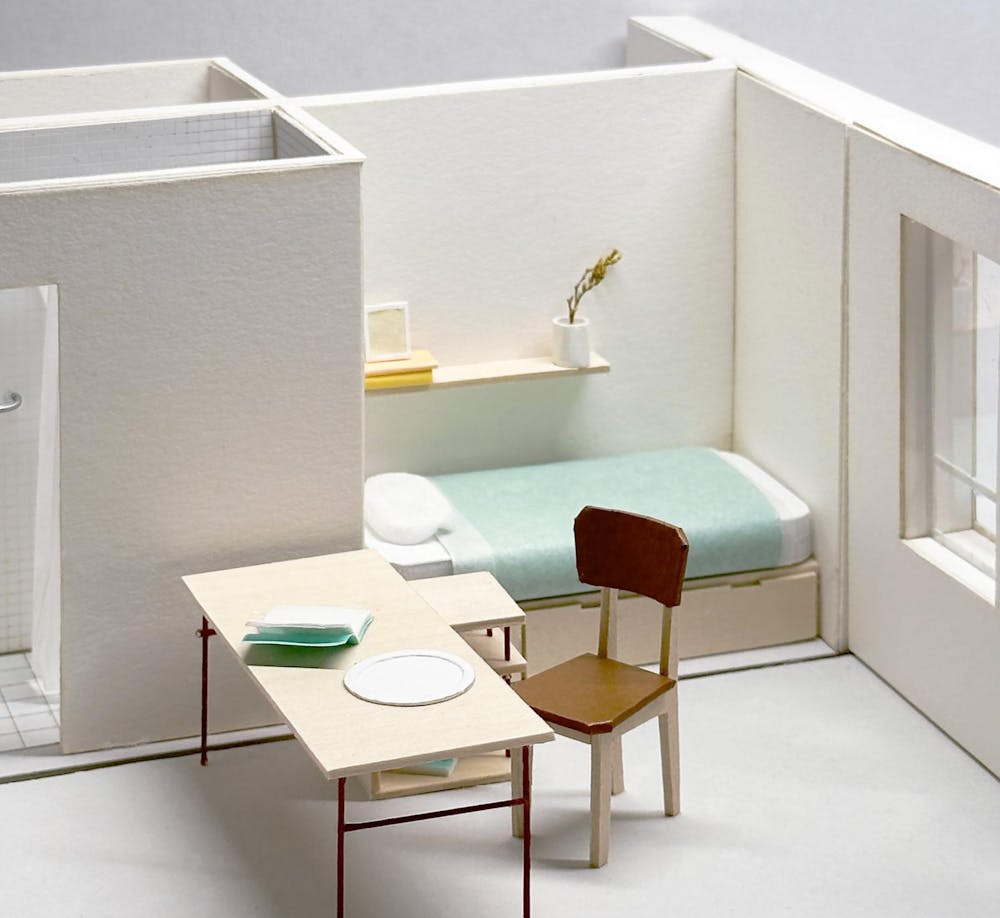Last fall, 12 Rhode Island School of Design students working under Associate Professor of Architecture Jonathan Knowles developed 12 designs for temporary housing buildings to present to state officials amid Rhode Island’s growing need for housing.
In 2019, Gov. Daniel McKee attended the ribbon-cutting for a set of buildings designed in one of Knowles’s previous architecture studios. After that, he proposed the idea of a studio to address housing solutions for the state’s unhoused population to Knowles. “By having students work on developing these designs, more ideas could be generated faster,” Knowles said. “We could give them a host of options (which) would probably be quite expensive for a firm to do.”
Once they decided that the studio would focus on temporary housing apartment complexes, McKee’s budget was clear: $30 million for five transitional housing buildings, with 60 units per building.
“Right now, especially in our state, we're really feeling the strain of not having enough housing stock for everyone,” said Lauren Barnes, a project manager for the Rhode Island Department of Housing. “We're in the midst of a huge push to develop housing at all levels.”
The proposed sites for the buildings were located in Providence, Central Falls, Woonsocket and West Warwick. Each location offered different challenges for the students to tackle.
Lela Gunderson, a master’s of architecture student, worked on the West Warwick site, which was “sandwiched between an elementary school and a park.” Hoping to integrate her housing into the broader community, Gunderson designed a playground for the children living in the building or attending the school.
Betty Ng, another student working on the West Warwick location, made the bottom floor of her building a community center. For her, it was important to balance public and private spaces, creating “common grounds where the residents can interact with each other.”
Lauren Blonde, who worked on a site in downtown Providence, was able to visit the location. “The site felt like a big kind of transportation area,” she said. Blonde noticed that while the site had a bus stop located conveniently nearby, noise pollution from the highway posed a potential problem.
“The biggest strategy was just to pull all the housing off of the highway,” she said. Near the highway, she kept some parking spots for workers staffing a clinic and other social service facilities she placed on the first floor of her building.
To keep construction time short, the students explored methods of prefabrication — building sections of the structure off-site, transporting them to the location and then fitting all the parts together. Theoretically, Knowles explained, the students’ end-of-semester designs could be finalized within three months and then constructed in about a year.
With construction time in mind, Blonde developed a three-sided furniture unit that could easily be dropped into a building without having to build a lot of walls. This type of innovation is exactly what the Department of Housing was looking for, Barnes said.
“Doing new and innovative things actually may be cheaper, maybe more efficient, maybe more energy efficient, maybe better for the planet … than any of our traditional building methods,” she added.
One of the goals of R.I.’s Department of Housing is “engaging with the people of our community on what the needs are, what they see as solutions and how folks can help,” Barnes said. Collaborations, such as the one with RISD, can help get students interested in working on housing solutions in their careers.
“We were really hoping to inspire students to want to do this professionally,” Barnes added. “If you see problems with how it's happening right now — that's great … Let's get you into the workforce and let's design some new things.”
Students also learned how to develop designs compliant with the Americans with Disabilities Act and balance innovative design techniques with practicality and function. “The priority here is not your own artistic vision,” Blonde said. “It is a real solution in service of a real problem.”
This winter, the state moved ahead with implementing pallet shelters, The Herald previously reported. But for Gunderson, the shelters are “really not ideal to live in: There's such a small amount of space that's actually assigned to each individual.”
“It's a lot harder to build community or to build a sense of resiliency in these houses because they don't offer that communal space,” Blonde said. “We ought to build something that feels like when you walk in, you're being embraced by a larger system that is here to help.”
For Barnes, pallet housing is “ great for a variety of reasons,” including the speed at which the structures can be set up. But, she explained, pallet shelters are “one piece of the puzzle.”
“We absolutely need all different kinds of housing,” she added. “I hope all of those students … help us with solutions.”
“I would really love to work on more projects like this again, in the future,” Gunderson said.
The Rhode Island Department of Housing plans to continue tackling the housing crisis through a mix of solutions, including emergency shelters, landlord incentives and rapid rehousing programs, according to Barnes. As for plans for the student designs, the possibilities are endless: “In a year or two, who knows? Who knows what's gonna be built?” she said.

Ciara Meyer is the managing editor of newsroom and vice president of the 136th Editorial Board. She is from Saratoga Springs, New York and plans on concentrating in Statistics and English Nonfiction. In her free time, she loves scrapbooking and building lego flowers.





